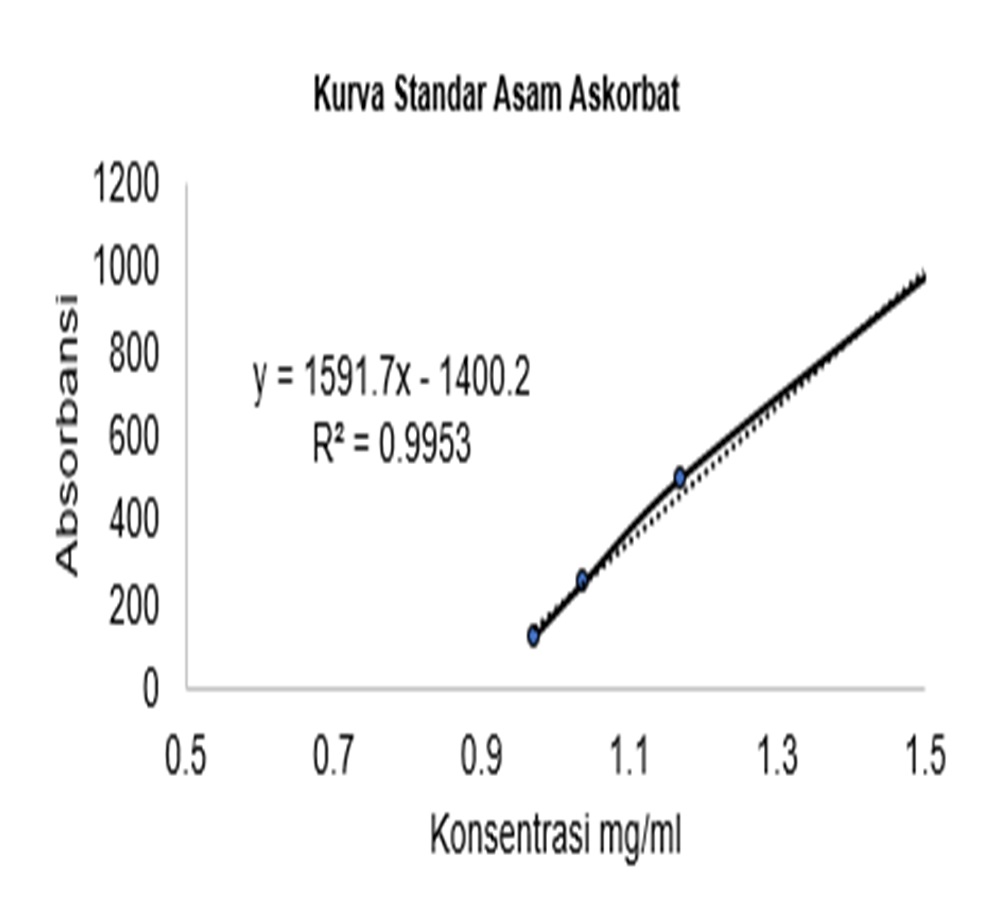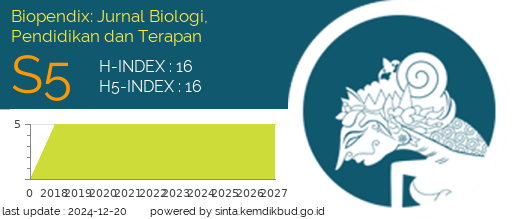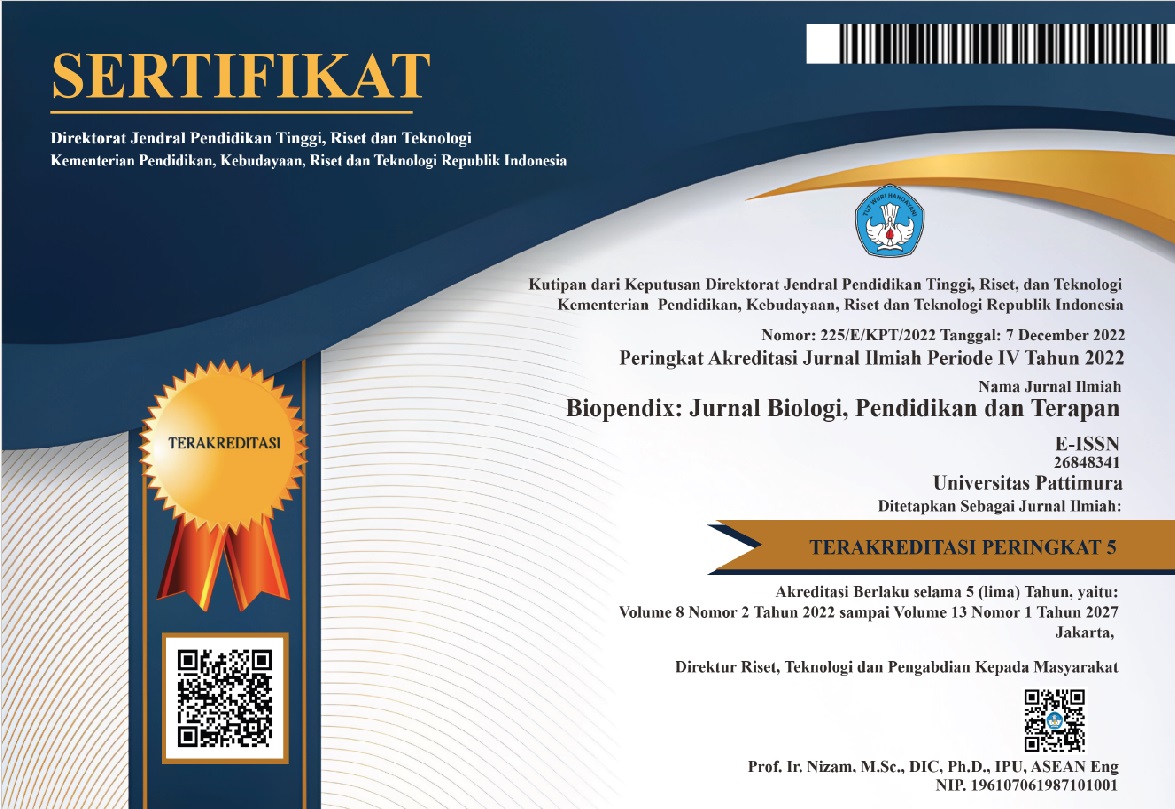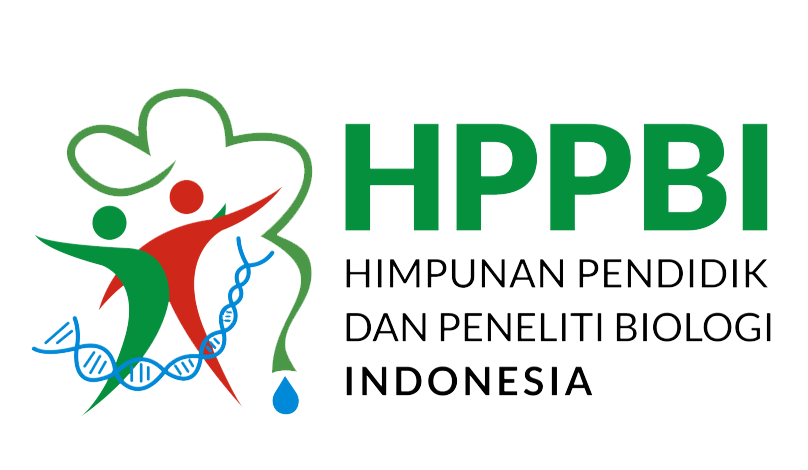PENGARUH WAKTU DAN SUHU PENYIMPANAN TERHADAP KADAR ASAM ASKORBAT BUAH PISANG
Abstract
Background: Bananas are widely consumed by the people due to their soft texture, easy digested, and can be consumed directly or processed again. This fruit has characteristics that are suitable for Indonesia’s growth climate. Asia ranks first as the largest banana producer, with Indonesia being the third-largest producer. Bananas are generally classified as a source of Vitamin C, also known as Ascorbic Acid. When consuming, many people store it in the refrigerator to keep it fresh. The increase in ascorbic acid content occurrs along with longer storage time. This research aims to study the changes in ascorbic acid levels in bananas due to the effects of storage time at room temperature and refrigerator temperature.
Methods: This research use a laboratory experimental by testing the levels of Ascorbic Acid contained in bananas using the spectrophotometry method in April 2024
Results: This research shows that the ascorbic acid content in bananas stored for varying durations at room temperature is lower than refrigerator temperature, and there is an interaction between storage time and storage temperature.
Conclusion: The decrease in ascorbic acid levels occurred due to the interaction between storage time and room temperature and refrigerator temperature
Downloads
References
Arifki, H.H., Barliana, M.I., 2018. Karakteristik dan Manfaat Tumbuhan Pisang di Indonesia. Farmaka 16, 196–203.
Arundana, M.E., Marwanti, S., Adi, K., 2019. Analisis Faktor-Faktor yang Mempengaruhi Keputusan Konsumen dalam Pembelian Buah Pisang Cavendish di Kota Surakarta. AGRISTA 7, 1–12.
Gropper, S.S., Smith, J.L., Carr, T.P., 2018. Advanced Nutrition and Human Metabolism. Cengage Learning.
Hapsari, Y.I., Lestari, Y.N.A., Prameswari, G.N., 2023. Pengaruh Suhu dan Lama Penyimpanan Terhadap Kadar Vitamin C pada Jus Jambu Biji (Psidium Guajava L.). Jurnal Gizi 12, 37–45.
Hasibuan, E.P., Widodo, W.D., 2015. Pengaruh Aplikasi KMnO4 dengan Media Pembawa Tanah Liat terhadap Umur Simpan Pisang Mas (Musa sp AA Group.). Bul. Agrohorti 3, 387–394.
Hayati, R., Irhamni, D., Hasanuddin, 2023. Pengaruh Tingkat Kematangan dan Lama Penyimpanan Terhadap Kualitas Pisang Mas (Musa acuminata Colla). Jurnal Agrotropika 20, 145–155.
Leo, R., Daulay, A.S., 2022. Penentuan Kadar Vitamin C Pada Minuman Bervitamin Yang Disimpan Pada Berbagai Waktu Dengan Metode Spektrofotometri UV. Journal of Health and Medical Science 1.
Liputo, S.A., Afrilianti, R.B., Fadhilah, A.N., Musa, A., Mado, R.F.D., Dewa, M.D., Muti, S., 2022. Analisis Kandungan Kimia dan Fisik Pada Irisan Buah Pisang (Musa paradisiaca) Setelah Disimpan Pada Suhu Rendah. Garba Rujukan Digital 1, 21–30.
Nazudin, Sabban, K., 2020. Pengaruh Lama Penyimpanan Terhadap Kadar Vitamin C Pada Buah Pisang musa Acuminate L (Varietas Pisang Kepok) dan Pisang Musa Paradisiaca L Kunt Var Sapientum (Varietas Pisang Ambon). Scie Map J 2, 8–14.
Ode, W., Sariamanah, S., Munir, A., Agriansyah, A., 2016. Karakterisasi Morfologi Tanaman Pisang (Musa paradisiaca L.) di Kelurahan Tobimeita Kecamatan Abeli Kota Kendari. J. AMPIBI 1, 32–41.
Rachmawati, R., Defiani, R., Suriani, L., 2009. Pengaruh Suhu dan Lama Penyimpanan Terhadap Kandungan Vitamin C Pada Cabai Rawit Putih (Capsicum frustescens). J Biol (Denpasar) XIII, 36–40.
Ross, C., Caballero, B., Cousins, R.J., Tucker, K.L., Ziegler, T.R., 2014. Modern Nutrition in Health and Disease. Wolters Kluwer, Philadelphia.
Setiawan, Maimunah, Suswati, 2020. Keragaman Parasitoid Erionota thrax l. pada Dua Jenis Tanaman Pisang Bermikoriza di Kabupaten Deli Serdang. Jurnal Ilmiah Pertanian (JIPERTA) 1, 106–111.
Wulandari, R.T., Widyastuti, N., Ardiaria, M., 2018. Perbedaan Pemberian Pisang Raja dan Pisang Ambon Terhadap VO2max pada Remaja di Sekolah Sepak Bola. Journal of Nutrition College 7.
Yuda, P.E.S.K., Suena, N.M.D.S., 2016. Pengaruh Suhu Penyimpanan Terhadap Kadar Tablet Vitamin C yang Diukur Menggunakan Metode Spektrofotometri UV-VIS. Jurnal Ilmiah medicamento 2, 23–27.

Copyright (c) 2025 Tasha Kumala Sari

This work is licensed under a Creative Commons Attribution-ShareAlike 4.0 International License.
Authors who publish with BIOPENDIX: Jurnal Biologi, Pendidikan dan Terapan agree to the following terms:
- Authors retain copyright and grant the journal right of first publication with the work simultaneously licensed under Creative Commons Atribution-ShareAlike 4.0 International License (CC BY-SA 4.0) that allows others to share the work with an acknowledgment of the work's authorship and initial publication in this journal.
- Authors are able to enter into separate, additional contractual arrangements for the non-exclusive distribution of the journal's published version of the work (e.g., post it to an institutional repository or publish it in a book), with an acknowledgment of its initial publication in this journal.
- Authors are permitted and encouraged to post their work online (e.g., in institutional repositories or on their website) prior to and during the submission process, as it can lead to productive exchanges, as well as earlier and greater citation of published work.




 2
2






